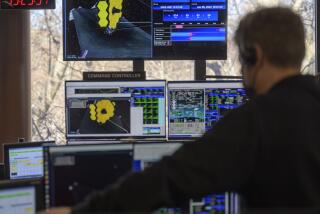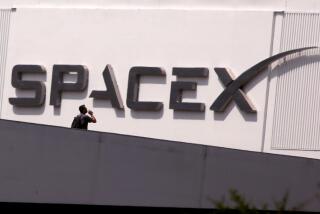TRW to Launch Hiring Effort
In a boost to Southern Californiaâs economy and its long-suffering aerospace industry, TRW Inc. plans to hire more than 1,000 engineers over the next year as a result of winning four major satellite contracts.
TRWâs Space and Electronics unit in Redondo Beach over the last nine months has scooped up government contracts potentially worth more than $14 billion. The achievement vindicates TRWâs strategy of focusing on advanced research, and it will help reverse the regionâs long slide in aerospace hiring.
âWe are going to go into an aggressive hiring mode,â said Timothy W. Hannemann, chief executive of TRWâs Space and Electronics unit in Redondo Beach.
In addition to the engineering jobs, hundreds of others are likely to be hired in support roles.
And Hannemann said even more jobs could be created as the programs begin in earnest over the next year or two.
âI feel pretty good about the future of this place and for the industry in Southern California.â
TRWâs resurgence is leading a turnaround for the regionâs defense industry after nearly two decades of retrenchment, economists said.
For the first time since 1988, economists are predicting sustained growth in aerospace jobs in the region.
âPeople think aerospace has gone away, but if you look at Southern California in the last few months, there has been an impressive string of contract wins,â said Jack Kyser, chief economist for the Los Angeles County Economic Development Corp. âThe decline in aerospace since 1988 has been pretty relentless, but weâre now looking at an uptick that should last for a while.â
The TRW contract wins were among the latest in a batch of major awards given to Southern California aerospace firms this year.
Last month, Boeing Co. won a $9.6-billion Pentagon contract to build 60 more C-17 military transport jets at its Long Beach plant. Boeingâs Seal Beach operations also garnered two defense contracts, one to design next-generation weapons for the Army, worth about $6 billion, and another to field a new radio system for about $4 billion.
Elsewhere, Century City-based Northrop Grumman Corp. is hiring 1,500 people to work on the Joint Strike Fighter in El Segundo and Palmdale.
The growth in jobs is not likely to come anywhere close to the industryâs heyday in the 1940s and 1950s, but the quality of the new jobs is expected to add significantly to the economy.
Historically, most of those jobs were in manufacturing, but the new jobs are largely for high-wage engineers.
The spacecraft contracts, which overnight doubled TRWâs backlog from $4 billion to $8 billion, will require the immediate creation of hundreds of high-paying engineering jobs.
About 8,000 people work in Redondo Beach, with an additional 1,000 scattered in other offices throughout the Southland.
Last week, TRW won a high-profile $825-million contract from NASA to build the next-generation space observatory to replace the Hubble Space Telescope.
Three weeks ago, TRW won its largest satellite production contract when it was selected to build weather-monitoring satellites for both military and civil use, potentially worth $6.5 billion.
In April, TRW was tapped to oversee a $6-billion satellite system to track enemy missiles, and earlier in the year it won a $1.3-billion contract to build instruments for a communications satellite system.
And there probably are other contracts that TRW has won but canât disclose because they involve classified Defense Department work, according to aerospace experts. Company officials declined to discuss this possibility.
âTRW is winning more contracts than we know about,â said William H. Alderman, an aerospace mergers and acquisitions specialist. âWith the Bush administrationâs current focus on bolstering military space programs, and Congress willing to fund those programs, TRW is in a very good position to win them. What they do fits really well with what the administration wants.â
Thatâs good news for hundreds of engineers who have been laid off from Boeingâs commercial satellite operations in El Segundo in recent months. The division has been hit hard by the slump in the telecommunications industry.
TRWâs hot streak appears to justify Northropâs logic for acquiring TRW. Northrop agreed to pay $7.8 billion for Cleveland-based TRW after a six-month battle that required Northrop to raise its bid three times.
Northrop has been eyeing TRWâs space business in Redondo Beach for nearly a decade. TRW also has a major automotive parts business and an aircraft parts operation, both of which Northrop wants to sell.
TRWâs space business will be one of Northropâs crown jewels, said Jon B. Kutler, president of Quarterdeck Investment Partners Inc., a Century City-based aerospace investment bank.
Northrop officials have declined to talk about the integration plans pending government approvals, but analysts anticipate that the company will not impose much change at TRW since there is little redundancy in operations.
But some TRW executives have said privately that they are looking forward to working for Northrop after years of frustration in the shadows of a company that had increasingly focused on less-than-stellar ventures into automotive and aircraft parts businesses.
âI think there was a lot of frustration with being a premiere space company sitting under an automobile parts maker,â an executive said.
Some TRW employees acknowledged feeling uncertain, with Northropâs acquisition, about whether TRW could maintain its culture focused around taking on the nationâs most challenging engineering tasks. The culture allowed engineers to feel secure in their jobs, they said.
TRW has been at the forefront of military weapons and space development, including having designed and launched more than 200 satellites since its predecessor was founded by two Caltech graduates in a Los Angeles barbershop in 1953. It developed the nationâs ballistic missile system and is a significant contractor for the missile-defense program.
The anxiety level appears to have diminished considerably in recent months with the successes in winning the major contracts. An executive at a rival aerospace company said he no longer gets resumes from TRW employees after a steady stream of them started to come in shortly after Northrop announced its acquisition of TRW earlier this year.
âIt just stopped overnight,â he said.
TRW officials attributed the contract wins partly to sticking with the strategy of retaining its core engineering work force despite intense pressure to make cost-cutting moves.
Although TRW slashed its payroll, mainly cutting administrative and support staffs, its engineering staff, which had worked on some of the nationâs more pioneering military programs, was mostly retained.
TRWâs research culture is embodied in its sprawling complex in Redondo Beach, which is modeled like a college campus with grass courtyards and bricked walkways.
Some 30 low-rise buildings make up the âspace park,â giving virtually every engineer an office with a window and a view, an idea pushed by the companyâs founders. They believed that the academic atmosphere would draw the nationâs best talent, foster creative thinking and help TRW maintain a technological edge over its competitors.
Despite coming under heavy criticism in the 1990s as a prolonged slump in defense spending led companies to shutter facilities and slash jobs, TRW stuck to its founding vision, a move that now appears to be paying off.
âOne of the objectives I had, as we went through this time of contraction, was to maintain our focus on investment in research and development, and I always thought that one of the strategic advantages would be to find a way to keep the best people,â said Hannemann, who has been chief executive of the space unit since 1993. âIâm glad to say weâve accomplished both objectives: We were able to keep and nurture the best and the brightest, and I think thatâs made a big difference in our success.â
More to Read
Inside the business of entertainment
The Wide Shot brings you news, analysis and insights on everything from streaming wars to production â and what it all means for the future.
You may occasionally receive promotional content from the Los Angeles Times.










